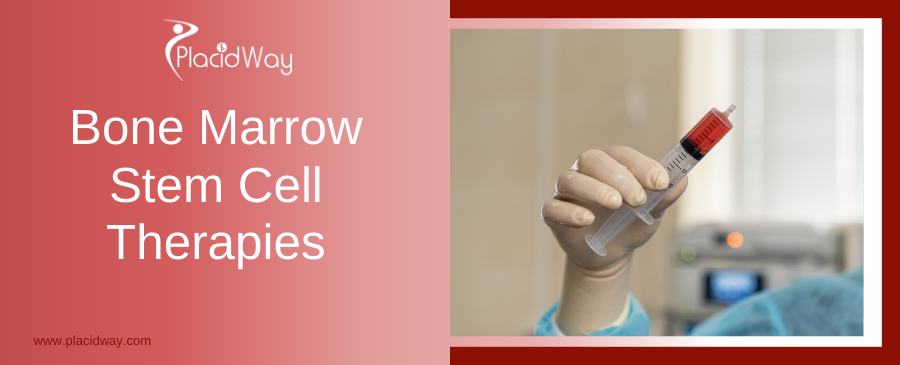
Unlocking Your Body's Healing Potential: Bone Marrow Stem Cell Therapies Explained
Imagine a treatment that harnesses your body’s own incredible ability to heal and regenerate. That’s precisely what Bone Marrow Stem Cell Therapies offer. These innovative medical procedures tap into the rich supply of mesenchymal stem cells (MSCs) and hematopoietic stem cells (HSCs) found within your bone marrow. These powerful cells are the body's natural repair crew, capable of differentiating into various cell types, reducing inflammation, and stimulating tissue repair.
For individuals grappling with persistent pain, degenerative conditions, autoimmune disorders, or even certain blood cancers, bone marrow stem cell therapy can represent a beacon of hope. It's an advanced form of regenerative medicine designed to not just mask symptoms, but to address the underlying cellular damage that causes them. Whether you're struggling with the stiffness of osteoarthritis, the chronic discomfort of a spinal injury, or the systemic challenges of an autoimmune disease, this therapy could offer a path toward improved function and a better quality of life.
Many patients consider bone marrow stem cell therapy when conventional treatments have failed or offer only temporary relief. It’s particularly appealing for those seeking less invasive alternatives to surgery or long-term medication use. As interest in these groundbreaking treatments grows, so does the opportunity for patients to access high-quality, affordable care through medical tourism. Exploring options abroad can open doors to world-class facilities and expert practitioners, often at a fraction of the cost, making life-changing regenerative medicine more accessible than ever before.
What Conditions Can Bone Marrow Stem Cell Therapies Treat?
Bone marrow stem cell therapies are incredibly versatile, offering potential relief and regeneration for a broad spectrum of conditions. The "symptoms of conditions treatable by stem cells" often involve chronic pain, inflammation, loss of function, and tissue degeneration. Here’s a closer look at common applications:
- Orthopedic Conditions: Often, patients search for "stem cell therapy for knees," "stem cell therapy for back pain," "shoulder pain stem cell treatment," or "arthritis treatment." These therapies can target:
- Osteoarthritis: Reducing pain and inflammation, promoting cartilage regeneration in joints like knees, hips, and shoulders.
- Spinal Disc Degeneration: Alleviating chronic back and neck pain by potentially repairing damaged discs.
- Tendon and Ligament Injuries: Accelerating healing of tears in rotator cuffs, Achilles tendons, or ACLs.
- Autoimmune Diseases: Patients may look for "stem cell therapy for MS," "lupus stem cell treatment," or "rheumatoid arthritis regenerative medicine." Stem cells can modulate the immune system and reduce inflammation in conditions such as:
- Multiple Sclerosis (MS)
- Lupus
- Crohn's Disease
- Rheumatoid Arthritis
- Neurological Conditions: While often experimental, some clinics explore these therapies for conditions like Parkinson's disease or stroke recovery, aiming to repair damaged neural pathways.
- Cardiovascular Diseases: Research explores its use in heart failure to repair damaged heart tissue.
- Blood Disorders and Cancers: This is the most established use, often referred to as a "bone marrow transplant," for conditions like leukemia, lymphoma, and aplastic anemia.
For many, the appeal lies in addressing the root cause of the issue, rather than just managing symptoms, leading to more sustainable improvements in quality of life.
Understanding the Root: Causes and Risk Factors for Conditions Treated by Stem Cells
The conditions benefiting from bone marrow stem cell therapy typically arise from a combination of factors that overwhelm the body's natural healing capabilities. Understanding these causes helps appreciate why regenerative medicine is so vital:
- Aging and Degeneration: As we age, our bodies naturally experience "wear and tear." Cartilage thins, discs lose hydration, and cellular repair processes slow down. This is a primary cause of osteoarthritis and degenerative disc disease.
- Acute Injuries and Trauma: Accidents, sports injuries, or surgical trauma can lead to significant tissue damage that struggles to heal completely, leaving chronic pain or instability. Tendon tears, ligament sprains, and fractures fall into this category.
- Inflammation: Chronic, uncontrolled inflammation is a common thread in many diseases. In autoimmune conditions like rheumatoid arthritis or lupus, the immune system mistakenly attacks healthy tissues, leading to persistent inflammation and damage.
- Genetics and Predisposition: Some individuals are genetically predisposed to certain conditions, such as specific blood cancers or autoimmune disorders, making them more susceptible even without overt external triggers.
- Lifestyle Factors: Obesity puts extra strain on joints, accelerating wear. Poor nutrition, smoking, and lack of exercise can also contribute to overall systemic inflammation and hinder the body's repair mechanisms.
- Environmental Factors: Exposure to certain toxins or radiation can damage bone marrow, leading to blood disorders.
When these factors lead to insufficient self-repair, introducing healthy, potent stem cells can provide the necessary boost to regenerate tissue and restore function.
Exploring the Types of Bone Marrow Stem Cell Procedures
When considering "types of bone marrow stem cell procedures," it's crucial to understand the distinction between using your own cells versus donor cells. This choice significantly impacts the procedure, recovery, and potential risks:
- Autologous Bone Marrow Stem Cell Therapy:
- What it is: "Autologous stem cell transplant" means the stem cells are harvested directly from the patient's own bone marrow, typically from the hip bone (iliac crest).
- Process: The bone marrow is aspirated, processed to concentrate the stem cells (often creating "Bone Marrow Aspirate Concentrate" or BMAC), and then immediately reinjected into the damaged area (e.g., knee joint, spinal disc, or intravenously).
- Advantages: No risk of immune rejection, lower risk of disease transmission.
- Uses: Primarily for orthopedic conditions (arthritis, joint injuries), spinal issues, and some autoimmune diseases.
- Allogeneic Bone Marrow Stem Cell Therapy:
- What it is: "Allogeneic stem cell transplant" uses stem cells from a matched donor (related or unrelated).
- Process: Donor stem cells are typically administered intravenously after the patient undergoes chemotherapy or radiation to suppress their immune system and prepare their bone marrow.
- Advantages: Can treat conditions where the patient's own bone marrow is diseased or damaged, provides a healthy immune system to fight certain cancers.
- Uses: Most commonly for blood cancers (leukemia, lymphoma), aplastic anemia, and other severe blood disorders.
- Considerations: Requires careful donor matching and carries a risk of "Graft-versus-Host Disease" (GvHD), where the donor cells attack the recipient's tissues.
The choice between autologous and allogeneic depends entirely on the condition being treated and the patient's specific medical profile.
Am I a Candidate? Eligibility for Bone Marrow Stem Cell Therapy
One of the most common questions patients have is, "Am I eligible for stem cell treatment?" Determining your suitability for bone marrow stem cell therapy involves a comprehensive medical evaluation. While criteria can vary based on the specific condition and the clinic's protocols, general considerations include:
- Diagnosis: A confirmed diagnosis of a condition treatable by stem cells (e.g., severe osteoarthritis, specific autoimmune disorder, or blood cancer).
- Overall Health: Good general health is crucial. Patients should not have active infections, uncontrolled chronic diseases (like severe heart disease or diabetes), or other health issues that could complicate the procedure or recovery.
- Bloodwork and Imaging: Comprehensive blood tests will assess your blood counts, organ function, and rule out any underlying infections or deficiencies. Imaging studies (MRI, X-rays) help evaluate the extent of tissue damage.
- Absence of Active Cancer: For regenerative applications (non-cancer treatment), an active malignancy is typically a contraindication, as there's a theoretical concern about stem cells stimulating cancer growth.
- Realistic Expectations: Patients should have a clear understanding of the potential benefits and limitations of the therapy. It's not a magic bullet, and results can vary.
- Age: While there isn't a strict age limit, very elderly patients or those with multiple comorbidities may have increased risks.
- No Recent Steroid Injections: For orthopedic applications, clinics often require a waiting period after corticosteroid injections in the target area, as steroids can inhibit stem cell function.
A thorough consultation with a qualified medical professional, often involving a review of your complete medical history and diagnostic tests, is essential to determine if this therapy is the right option for you.
What Does Recovery Look Like After Bone Marrow Stem Cell Therapy?
"Recovery after stem cell therapy" is a common patient query, and the experience can differ significantly depending on the type of procedure and the condition being treated:
- For Autologous Regenerative Injections (e.g., BMAC for joints):
- Immediate Post-Procedure: You might experience mild to moderate soreness, bruising, or swelling at the bone marrow aspiration site (usually the hip) and at the injection site. This typically subsides within a few days.
- Downtime: "Stem cell therapy downtime" for these procedures is minimal. Most patients can resume light activities within 1-3 days, avoiding strenuous exercise for 1-2 weeks.
- Expected Improvements: Healing is a gradual process. Patients often report initial improvements in pain and function within 4-6 weeks, with continued progress over 3-6 months as the cells work to regenerate tissue. Full benefits can take up to a year.
- For Allogeneic Transplants (e.g., for blood cancers):
- Hospital Stay: This is a much more intensive procedure, requiring a hospital stay of several weeks for the transplant itself and initial recovery.
- Acute Recovery: Patients will experience side effects from the chemotherapy/radiation (nausea, fatigue, hair loss) and may be vulnerable to infections as their new immune system develops.
- Long-Term Recovery: Full recovery can take several months to a year or more. Regular follow-ups, medications to prevent GvHD, and careful monitoring are essential.
Regardless of the procedure, physical therapy and adherence to post-treatment guidelines are crucial for optimizing results. Patience is key, as cellular regeneration takes time.
Understanding the Risks and Side Effects of Stem Cell Treatments
Patients often ask, "Are stem cell therapies safe?" and "What are stem cell therapy risks?" Like any medical procedure, bone marrow stem cell therapies carry potential risks and side effects, though generally considered low when performed by experienced professionals in regulated environments:
- At the Bone Marrow Aspiration Site (for autologous procedures):
- Pain and Bruising: The most common side effect is localized pain, soreness, or bruising at the hip where the bone marrow is drawn. This usually resolves within a few days.
- Infection: Any invasive procedure carries a small risk of infection, minimized by sterile techniques.
- Bleeding/Hematoma: Minor bleeding or a collection of blood (hematoma) can occur.
- Nerve Damage: Extremely rare, but possible if a nerve is inadvertently irritated during aspiration.
- At the Injection Site (for regenerative procedures):
- Pain and Swelling: Temporary discomfort, swelling, or redness at the site where stem cells are injected.
- Infection: Again, a rare but possible risk.
- For Allogeneic Transplants (using donor cells):
- Graft-versus-Host Disease (GvHD): A significant risk where the donor immune cells recognize the recipient's body as foreign and attack it. This can range from mild to life-threatening.
- Immune Suppression: Medications to prevent GvHD increase the risk of infection.
- Organ Toxicity: From chemotherapy/radiation prior to transplant.
- General Risks (for any type):
- Allergic Reaction: Though rare, an allergic reaction to anesthetics or other substances used in the procedure is possible.
- Tumor Formation: A theoretical concern, particularly with embryonic or induced pluripotent stem cells. With adult bone marrow stem cells (MSCs), the risk is considered very low by leading researchers, especially when used autologously and not manipulated significantly outside the body.
It is paramount to choose a reputable clinic with rigorous safety protocols and to have a thorough discussion with your doctor about all potential risks.
Worldwide Cost Comparison: How Much Do Bone Marrow Stem Cell Therapies Cost?
The question, "How much does stem cell therapy cost internationally?" is a driving factor for many considering treatment abroad. The price of bone marrow stem cell therapy varies widely based on several factors:
- Type of Procedure: Autologous procedures (like BMAC injections for joints) are typically less expensive than complex allogeneic bone marrow transplants for cancers, which can involve extensive hospital stays and preparatory treatments.
- Condition Treated: More severe or complex conditions may require multiple treatments or more sophisticated protocols, impacting the overall cost.
- Clinic and Location: Prestige, technology, and location of the clinic significantly influence pricing.
- Country: Labor costs, regulatory environments, and healthcare infrastructure vary greatly from country to country.
- Inclusions: Some prices include initial consultations, diagnostics, follow-up, and even accommodation, while others only cover the procedure itself.
Here's a general "stem cell treatment cost abroad" comparison, illustrating the potential savings:
| Country | Estimated Cost Range (Autologous, Regenerative) | Estimated Cost Range (Allogeneic Transplant) |
|---|---|---|
| United States | $8,000 - $25,000+ per treatment | $150,000 - $500,000+ |
| Mexico | $5,000 - $15,000+ per treatment | $40,000 - $100,000+ |
| Costa Rica | $7,000 - $18,000+ per treatment | $50,000 - $120,000+ |
| Germany | $10,000 - $25,000+ per treatment | $80,000 - $200,000+ |
| India | $3,000 - $10,000+ per treatment | $20,000 - $60,000+ |
| Thailand | $6,000 - $15,000+ per treatment | $30,000 - $80,000+ |
Note: These are estimated ranges and can fluctuate based on specific clinic, patient needs, and exchange rates. Always request a personalized quote.
Why Consider Bone Marrow Stem Cell Therapy Abroad?
The decision to pursue medical treatment outside your home country, often referred to as medical tourism, is a growing trend, especially for advanced therapies like bone marrow stem cell treatments. Here are the key reasons why patients look abroad:
- Cost-Effectiveness: This is arguably the most significant factor. As seen in the cost comparison, the same high-quality procedure can be dramatically more affordable in countries like Mexico, India, or Thailand compared to the U.S. or Western Europe. This saving often extends to travel and accommodation.
- Access to Advanced Therapies: Some cutting-edge stem cell protocols and applications may be more readily available or approved in certain countries abroad than in your home country, especially if they are still undergoing extensive trials locally.
- Reduced Waiting Times: In many public healthcare systems, waiting lists for specialized treatments can be prohibitively long. Traveling abroad often allows for immediate or significantly faster access to desired therapies.
- Privacy and Anonymity: For some, the privacy of receiving treatment away from their local community is appealing.
- Combining Treatment with Travel: Patients can combine their medical procedure with a relaxing vacation, turning a medical necessity into an opportunity for cultural exploration and recuperation in a beautiful setting.
- Second Opinions and Specialized Expertise: Access to a wider pool of international specialists allows patients to seek multiple opinions and find clinics with niche expertise in their specific condition.
Ultimately, medical tourism for bone marrow stem cell therapy offers a compelling blend of affordability, accessibility, and quality for those seeking innovative healing solutions.
Which Countries Offer the Best Value and Quality for Stem Cell Treatments?
When searching for "best countries for stem cell therapy," patients are looking for a balance of excellent medical care, strong regulatory oversight, and reasonable costs. Several nations have emerged as leaders in medical tourism for bone marrow stem cell therapies:
- Mexico: A top destination for North Americans due to its proximity and significantly lower costs. Many clinics are JCI-accredited and staffed by U.S.-trained physicians, offering a range of regenerative therapies.
- Costa Rica: Known for its beautiful environment and high-quality, personalized medical care. It's an attractive option for those seeking a tranquil recovery experience alongside advanced treatments.
- Germany: Renowned for its stringent medical regulations and advanced research. German clinics often employ highly specialized doctors and cutting-edge technology, albeit at a higher price point than some Asian or Latin American options.
- South Korea: A global leader in medical technology and research, particularly in regenerative medicine. South Korean clinics offer state-of-the-art facilities and highly skilled practitioners, often focusing on neurological and orthopedic applications.
- Thailand: A long-established medical tourism hub, offering world-class hospitals, experienced specialists, and luxurious recovery environments at highly competitive prices. It's particularly strong in orthopedic and anti-aging stem cell applications.
- India: Offers some of the most affordable treatment options with a growing number of internationally accredited hospitals and highly qualified doctors, particularly for blood-related conditions and transplants.
Each country has unique strengths, so research into specific clinic accreditations, doctor qualifications, and patient reviews is essential to find the best fit for your needs.
What to Expect When Traveling for Bone Marrow Stem Cell Therapy Abroad?
Embarking on a medical journey abroad can seem daunting, but with proper planning, it can be a smooth and rewarding experience. Here's a general roadmap of "what to expect when traveling for this procedure":
- Initial Consultation & Medical Records Review:
- Remote Consultation: Your journey typically begins with a remote consultation. You'll submit your medical history, diagnostic reports (MRIs, X-rays, blood tests), and current health status to the chosen international clinic or a medical tourism facilitator like PlacidWay.
- Treatment Plan & Quote: Based on your records, the medical team will assess your eligibility and propose a personalized treatment plan, including the procedure details, estimated duration of stay, and a comprehensive cost quote.
- Travel Planning:
- Logistics: Once you accept the plan, you'll arrange flights, accommodation, and local transportation. Many clinics or facilitators assist with these arrangements, sometimes offering packages.
- Visa & Documentation: Ensure you have a valid passport and any necessary visas for your destination country.
- Arrival & Pre-Procedure Assessments:
- Arrival: Upon arrival, you'll have an in-person consultation with your doctor.
- Further Diagnostics: Additional blood tests, physical exams, or imaging may be performed to confirm your condition and ensure you're optimally prepared for the procedure.
- The Procedure:
- Treatment Day: The procedure itself will be scheduled. For autologous bone marrow therapies, this involves aspiration and then re-injection on the same day. For allogeneic transplants, it's a more involved process over several weeks.
- Post-Treatment Recovery & Follow-up:
- Recovery: Depending on the procedure, you'll have a period of recovery, which might involve a few days in the local area for autologous treatments or several weeks for transplants.
- Post-Procedure Instructions: You'll receive detailed instructions for post-treatment care, physical therapy, and follow-up.
- Return Home: You'll then return to your home country to continue your recovery and potentially report progress remotely to your international clinic.
A good medical tourism facilitator can significantly streamline this entire process, ensuring a smooth and stress-free experience.
How to Ensure Safety and Quality for Bone Marrow Stem Cell Therapy Abroad?
The desire for "safety and quality abroad" is paramount when considering any medical procedure, especially one as advanced as bone marrow stem cell therapy. Here’s how you can minimize risks and ensure you receive the best care:
- Seek International Accreditation: Look for clinics accredited by reputable international organizations like the Joint Commission International (JCI). JCI accreditation signifies that a hospital meets stringent global healthcare standards for patient safety and quality of care.
- Verify Physician Credentials and Experience:
- Research the treating physicians' qualifications, board certifications, and experience specifically in bone marrow stem cell therapies.
- Ensure they have a strong track record and are specialists in regenerative medicine or the specific field related to your condition.
- Understand Regulatory Oversight: Research the regulatory environment for stem cell therapies in the destination country. Does the government regulate these treatments? Are there clear guidelines? Avoid clinics operating in countries with little to no oversight.
- Transparent Communication: The clinic should provide clear, understandable information about the procedure, expected outcomes, potential risks, and costs. Be wary of clinics that make unrealistic promises or offer "miracle cures."
- Review Patient Testimonials and Outcomes: Look for credible patient reviews, success stories, and, if possible, connect with former patients. While individual results vary, a pattern of positive experiences indicates quality.
- Facility Standards: Ensure the clinic maintains high standards of hygiene, uses state-of-the-art equipment, and adheres to strict sterile protocols to prevent infections.
- Engage with a Reputable Medical Tourism Facilitator: Companies like PlacidWay specialize in vetting international clinics, arranging logistics, and providing support, adding an extra layer of security and guidance to your journey.
Diligent research and clear communication are your best allies in ensuring a safe and high-quality experience.
Patient Success Stories: Real-World Experiences with Stem Cell Therapy Abroad
The true measure of any medical procedure lies in the experiences of those who undergo it. While individual results can vary greatly, "patient success stories" offer a powerful glimpse into the transformative potential of bone marrow stem cell therapies received abroad:
- Eliza, 58, from Canada: "My severe knee osteoarthritis had me on strong painkillers and facing surgery. After a bone marrow stem cell injection in Costa Rica, within three months, I was walking with less pain and could enjoy my garden again. It wasn't an instant fix, but the gradual improvement has been life-changing. The cost was also a fraction of what I was quoted at home."
- Mark, 45, from the UK: "Chronic back pain from a degenerated disc made daily life a struggle. I went to a specialized clinic in Mexico for an autologous bone marrow treatment. The whole experience, from the professional staff to the detailed aftercare, was exceptional. I'm now back to playing golf, something I thought was impossible. It truly felt like I got my life back."
- Sophia, 62, from Australia: "I was diagnosed with an autoimmune condition causing severe joint inflammation. After exploring options, I chose a clinic in Germany for bone marrow stem cell therapy. The precision of the treatment and the follow-up care were outstanding. My inflammation markers have reduced significantly, and I have more energy than I've had in years. The investment was worth every penny for my quality of life."
- David, 70, from the USA: "My doctor recommended a bone marrow transplant for my blood disorder, but the waiting list and cost in the US were daunting. I found a highly reputable hospital in India through PlacidWay. The doctors were brilliant, and the care was phenomenal. I’m now in remission, and I'm so grateful I looked beyond my borders for treatment."
These stories highlight that for many, traveling abroad for bone marrow stem cell therapy is not just about cost savings, but about accessing high-quality care that delivers tangible improvements in health and well-being.
Take the Next Step with PlacidWay
Ready to explore treatment options abroad? Discover top clinics, compare prices, and get a free quote tailored to your needs with PlacidWay.
Stem Cell Therapy Abroad





.png)

.png)
.png)

Share this listing